


Seed is an important component of agricultural production, on which depends the performance and efficiency of other inputs. Quality seed maintains high standards of genetic quality (containing seed of one variety only and having characteristics of targeted variety), physical quality (equal size healthy seed, free from stone, soil, damaged seed, immature seed and weed seeds, etc.), physiological quality (high germination percentage and seed viability), pathological quality (free from disease causing organism and pest) and with a proper moisture content and weight. It is necessary to follow best management practices for seed production and its post-harvest facilities to make available quality seed for the state. Certified seed production has to pass through two phases:

The main criteria for describing seed quality are:


Quality seed is high in genetic purity, high in germination and vigor, and of good quality (i.e., free from diseased, deformed, damaged or immature seeds). Quality seed can belong to three classes – breeder, foundation and certified seed. Quality seeds from the informal sector also can be termed truthfully labeled and/or good seed.


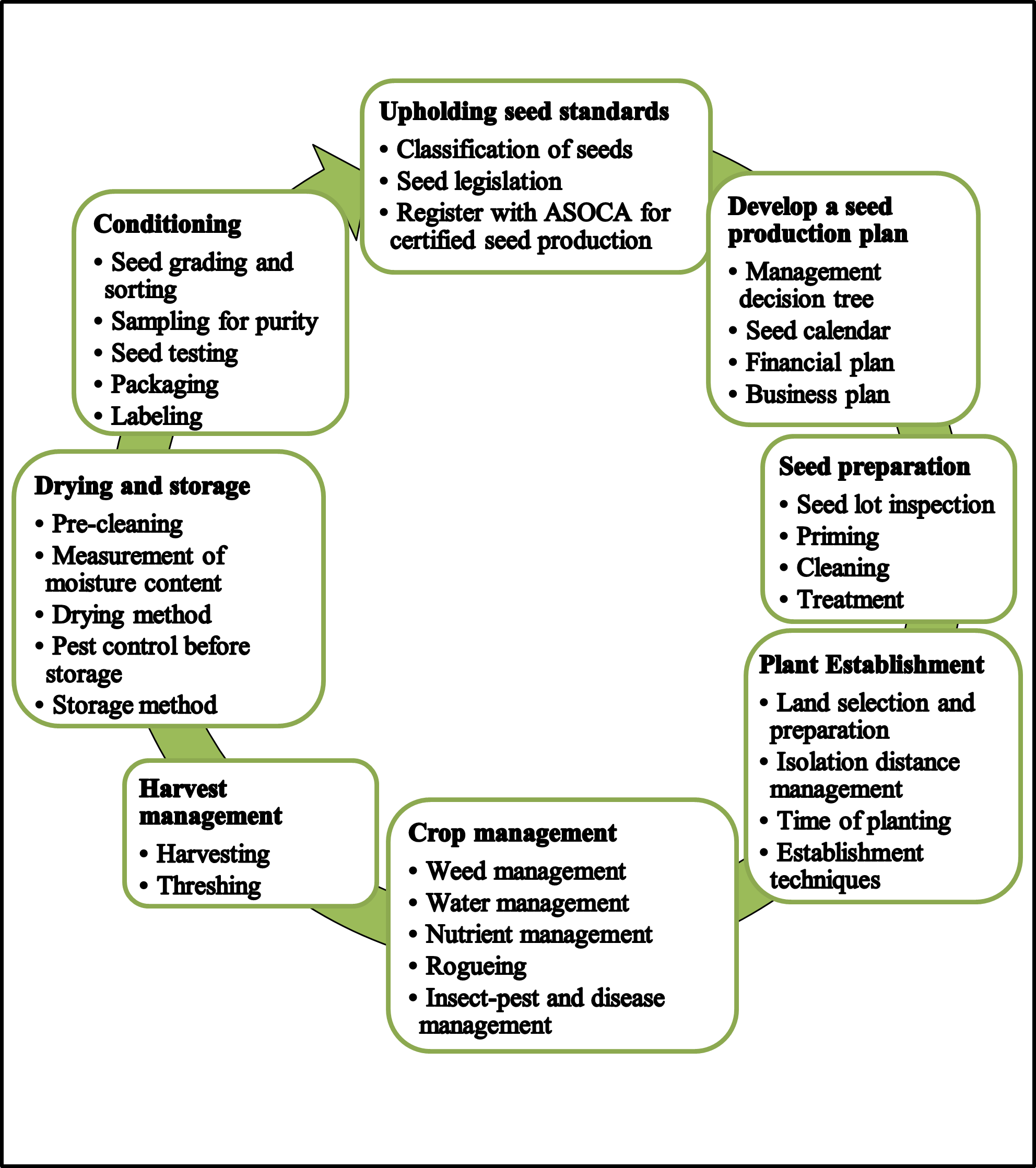
The farmers should follow the following activities step by step for successful seed production - (3.1.) Upholding seed standards (3.2.) Develop a seed production plan (3.3.) Seed preparation (3.4.) Plant establishment (3.5.) Crop management (3.6.) Harvest management (3.7.) Drying and storage (3.8.) Conditioning.
The purpose of seed certification is to maintain high quality and genetic purity of seeds of superior cultivars. Certified seed is high in genetic purity, high in germination rate, vigor and good quality (i.e., free from diseased, deformed, damaged or immature seeds).
For seed to be certified, the fields must be inspected by a certifying officer at least three times, at vegetative, flowering and grain filling stages, and the seed must be submitted to seed testing laboratory for testing for purity, cleanliness and health. The composite sample is divided into three equal parts, and one part is sent for analysis to the zonal seed testing laboratory, the second part to the seed producer and third part may be kept by the Assistant Seed Certification Officer (ASCO) as a guard sample. The specimen tags of breeder seed, foundation seed and certified seed are presented below:

Seed samples are collected and submitted for laboratory analysis after drying and processing. Tests are conducted for physical and genetically purity of the variety, presence of weed seed, other crop seed, inert matter, other variety seed, germination and moisture content. Maximum size of seed lot is 20,000 kg and sample submission size for paddy is 400 grams for seed analysis. The testing report need to be completed within 30 days from the date of receipt of samples, unless the seed is subjected to such tests which requires more than thirty days for completion.
Due to rapid development of agricultural production with introduction of hybrid varieties of maize, sorghum, pearl millet, dwarf wheat and paddy necessitated the enactment of Seed Legislation on December 29, 1966; the Seed Act was passed followed by Seed Rules in 1968. Both were adopted during 1969 by all the states of India, except Sikkim. The information of seed act 1966, seed control order 1983, new policy on seed development 1988, seed bill 2004 and seed bill 2019 are presented below:
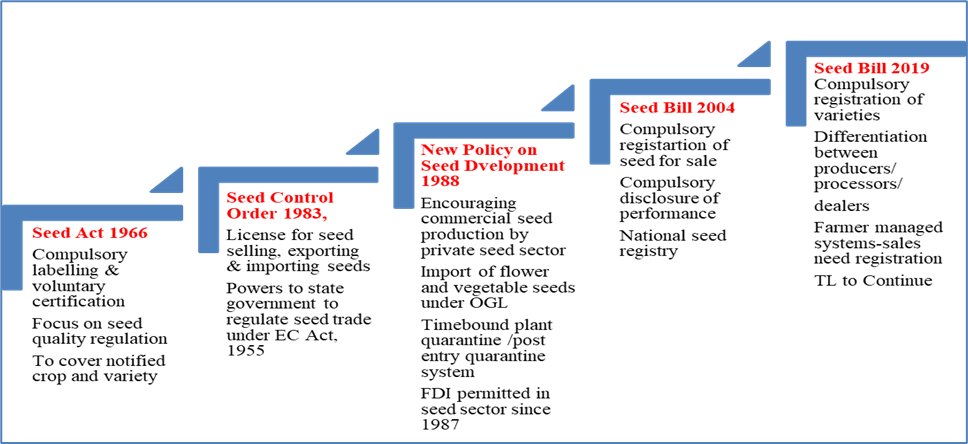
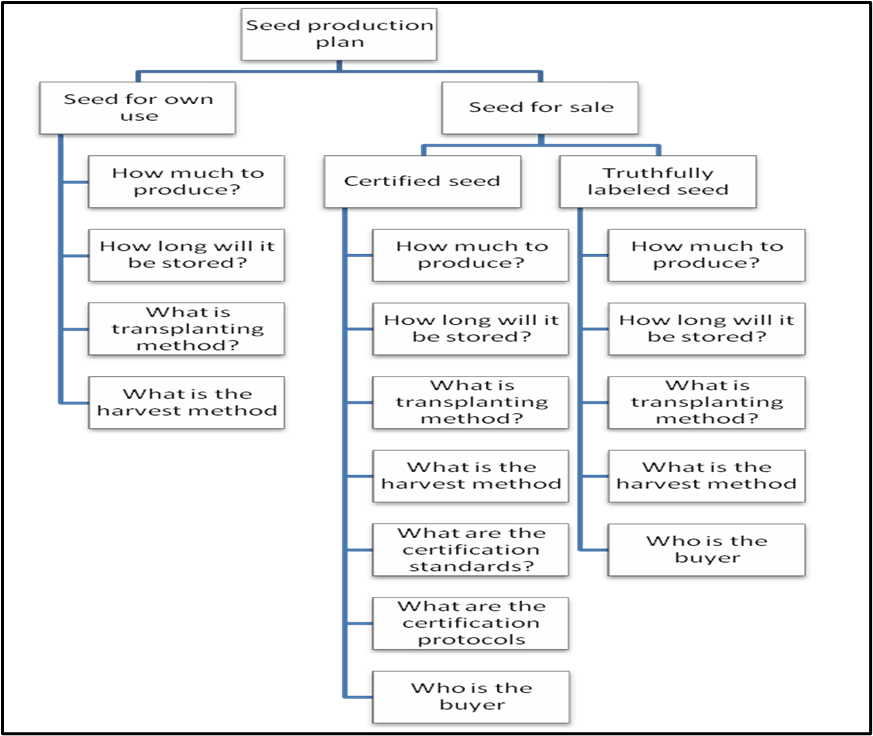
A seed production calendar is a picture of the rice-growing season for seed production from fallow period and land preparation, to crop establishment and maintenance through timely harvesting and proper storage facility. The seed production plan enables a farmer to plan for input purchase and use, develop cash-flow budget for the year, determine credit need and period of requirement, determine labor requirements and plan for peak usage times, organize contractors for land preparation and harvesting, prepare the seed inspection and field standards (if producing certified seed) and investigate marketing and selling options and linkages. There are three steps to finalize the seed production plan: (i) Creating a seed production calendar, (ii) Creating a financial plan, and (iii) if selling the seed, creating a marketing plan.
There are certain decisions to be made before the seed production plan is created. Use a decision tree to arrive at some conclusions before you proceed with the seed production plan.

For a farmer to make informed decisions, s/he must understand the basics of financial management and be able to analyze her/his business financially to plan future activities and compare enterprises. Understanding the differences between gross income, fixed and variable costs, gross margins, and return to management investment, is important. The total cost to produce a rice crop, is a combination of variable or operating costs and fixed or overhead costs. By understanding these costs, a farmer can determine what commodities s/he should produce, what grain yield and prices s/he needs to attain to make a profit, and what financial return he/she can get that is commensurate to her/his investment and personal efforts.
Follow these 5 steps to create a business plan:
The use of certified seed is a prerequisite for increasing the grain yield and successful production of a good quality crop. There are a few steps to be followed before planting the seed. The certified seed purchased must be used to grow the quality seed by the farmers for two years. To maintain the quality of purchased certified seed to be used for two years, the farmer should follow the seed production process. Seeds might be certified or purchased from a credible and trusted source, but a few simple steps will help to ensure that the seed being used is of the required quality.
The seed cleaning should be done in salt solution at a concentration of 200g common saltper litre of water. To check optimum concentration of the solution, put a potato/egg in solution, and go on adding salt till it floats. After that, seed should be poured into the prepared solution for cleaning. The light and diseased seeds, which float on the prepared solution, should be removed. The seeds settled at the bottom should be cleaned three times with plain water to remove any traces of salt that may hamper germination.
The cleaned seed should be kept for 12-24 hours in water before the fungicidal treatment. Seed treatment prevents seed and soil-borne diseases and avoids incidence of damping off, wilt and root-rot diseases in the seedling stage. It improves germination, seedling vigor, and thereby crop productivity. The recommended fungicide for seed treatment is Carboxin @ 2.5 g/kg of seed.
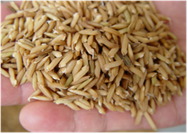

Plastic gloves should be used while handling chemicals to avoid ill-effects on health.
Fields that are used for growing certified seed must meet a number of criteria:
The "isolation distance" between a seed crop of a particular variety and a crop of a different variety is a space separating the crops large enough to prevent cross pollination. A safe minimum isolation distance from neighboring crops of different inbred rice varieties is 3 meters. The larger the seed plot, the less the danger of out-crossing. The isolation distance is compulsory for certified/quality seed production by seed growers.
Planting the crop on time will help to produce a fast growing, uniform crop that will have higher grain yield and will be better able to compete with weeds and pests.
Transplanting is better than other approach for seed production. Transplanted crops can be established manually, either in rows or randomly, or by machine. The rice varieties suited to transplanting should not be direct-seeded for seed production. Seed production with rice varieties suited to direct-seeded can be done through direct seeding. Wet direct seeding of rice and dry direct seeding of rice is done through drum seeder, and seed drill, respectively.
Weeds compete directly with the rice plants and reduce rice yield. Each 1 kg dry matter of weeds is equivalent to 1 kg grain loss. Weeds cause most yield loss within the first 20-50 days after crop establishment. Weeding after panicle initiation may also be important to prevent weed-seed shedding in future crops.
The list of herbicides to be used is presented in below table.
| When does it kill weeds | Chemical Name | Dose (ai, g/ha) | Type of weeds it kills | Type of weeds it kills | When to apply | Commercial dose (g or ml/ha) | Commercial dose (g or ml/bigha) |
|---|---|---|---|---|---|---|---|
| Pre- emergence (PE) | Pyrazosulfuron Ethyl 10% WP | 25 | Narrow leaf (sedges) | Some broad leaf | 0-3 DAT | 187.5 ml | 25 ml |
| Pre- emergence (PE) | Oxadiargyl 80% WP | 100 | Narrow leaf | Some broad leaf | 0-3 DAT | 125 g | 16.6 g |
| Post- emergence (PoE) | Bispyribac- sodium 10% EC | 25 | Narrow leaf (grasses + sedges) | Some broad leaf | 15-25 DAT | 250 g | 33 g |
| Post- emergence (PoE) | Chlorimuron ethyl 10%WP + Metsulfuron methyl 10% WP | 25 | Broad leaf | Some sedges | 15-25 DAT | 20 g | 3 g |
| Post- emergence (PoE) | Pyrazosulfuron Ethyl 10% WP | 25 | Narrow leaf (sedges) | Some broad leaf | 15-25 DAT | 250 g | 33 g |
DAT= Days after transplanting
fb*: followed by
Water availability largely determines the potential yield of a crop. To continue growth, a crop requires water supply similar to or a little above evaporation. In an efficient system, each 1 kg of rice seed produced will require a minimum of 2000 liters (2 m³) of water. Good water-control increases crop yields as well as seed quality and improves the efficiency of other inputs such as fertilizer, herbicide, and pesticides.
Good quality water is necessary to maximize crop growth. In some parts of Assam, iron is found predominantly in irrigation water. To reduce the intensity of iron problem, irrigation water needs to be passed through the long grassy channels allowing the water to oxidize either by trampling, releasing the ducks in rice fields. Applying undecomposed cow dung or potassium can also decrease the intensity of the iron toxicity problem. The practices that increase the water use efficiency in the main field are depicted below:

Fertilizer needs to be applied to increase crop yield. In some cases, fertilizers are also added as amendment to improve the soil physical condition. The amount and type of fertilizer applied are determined on the assumption that 1 ton of paddy seed will remove 15kg nitrogen, 2-3kg phosphate and 15-20kg of potash. These base rates need to be modified according to the soil type, season, crop condition, prevailing weather conditions and efficiency of application. For efficient fertilizer use:
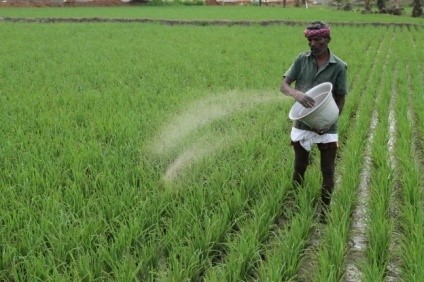
| When? | What? | How much? (g/m²) | How much? (g/m²) | How much? (kg/1000 m²) | How much? (kg/1000 m²) | Application method |
|---|---|---|---|---|---|---|
| When? | What? | Through DAP | Through SSP | Through DAP | Through SSP | Application method |
| Basal (Same day as sowing) | Manure | 2000 | 2000 | 2000 | 2000 | Soil incorporation |
| Basal (Same day as sowing) | Urea | 5.6 | 6.5 | 5.6 | 6.5 | Soil incorporation |
| Basal (Same day as sowing) | DAP | 2.2 | - | 2.2 | - | Soil incorporation |
| Basal (Same day as sowing) | SSP | - | 6.3 | - | 6.3 | Soil incorporation |
| Basal (Same day as sowing) | MOP | 3.3 | 3.3 | 3.3 | 3.3 | Soil incorporation |
| Stage of fertilizer application | Name of fertilizer | Fertilizer application (kg/ha) | Fertilizer application (kg/ha) | Fertilizer application (kg/bigha) | Fertilizer application (kg/bigha) | Application method |
|---|---|---|---|---|---|---|
| Basal (Same day at transplanting) | Urea | 23.0 | 40.0 | 3.1 | 5.3 | Broadcast & incorporate in soil at the time of field preparation |
| Basal (Same day at transplanting) | DAP | 43.0 | - | 5.7 | - | Broadcast & incorporate in soil at the time of field preparation |
| Basal (Same day at transplanting) | SSP | - | 125.0 | - | 16.7 | Broadcast & incorporate in soil at the time of field preparation |
| Basal (Same day at transplanting) | MOP | 66.7 | 66.7 | 8.9 | 8.9 | Broadcast & incorporate in soil at the time of field preparation |
| Basal (Same day at transplanting) | ZnSO4 | 25.0 | 25.0 | 3.3 | 3.3 | Broadcast & incorporate in soil at the time of field preparation |
| Tillering (20-25 DAT), after first weeding | Urea | 45.0 | 45.0 | 6.0 | 6.0 | Broadcast |
| Panicle initiation (40-45 DAT), after second weeding | Urea | 45.0 | 45.0 | 6.0 | 6.0 | Broadcast |
| 5-7 days after flood recedes | Urea | 45.0 | 45.0 | 6.0 | 6.0 | Broadcast |
| 5-7 days after flood recedes | MOP | 33.0 | 33.0 | 4.4 | 4.4 | Broadcast |
The detailed schedule and method of applying all nutrients in Boro/ early Ahu season is given in the table below:
| Stage of fertiliser application | Name of fertilisers | Fertiliser application (kg/ha) | Fertiliser application (kg/ha) | Fertiliser application (kg/bigha) | Fertiliser application (kg/bigha) | Application method |
|---|---|---|---|---|---|---|
| Basal (Same day at transplanting) | Urea | 18 | 43 | 2.4 | 5.7 | Broadcast & incorporate in soil at the time of field preparation |
| Basal (Same day at transplanting) | DAP | 65.2 | - | 8.7 | - | Broadcast & incorporate in soil at the time of field preparation |
| Basal (Same day at transplanting) | SSP | - | 187.5 | - | 25.0 | Broadcast & incorporate in soil at the time of field preparation |
| Basal (Same day at transplanting) | MOP | 50 | 50 | 6.7 | 6.7 | Broadcast & incorporate in soil at the time of field preparation |
| Basal (Same day at transplanting) | ZnSO4 | 25 | 25 | 3.3 | 3.3 | Broadcast & incorporate in soil at the time of field preparation |
| Tillering (20-25 DAT), after first weeding | Urea | 43 | 43 | 5.7 | 5.7 | Broadcast |
| Panicle initiation (40-45 DAT), after second weeding | Urea | 44 | 44 | 5.9 | 5.9 | Broadcast |
Rogueing is the removal of all off-types or mixtures of plants from the seed production field. Rogueing is extremely important to prevent pollen from off-type plants causing damage to the crop through cross-pollination. Plants with heterogeneous characters in a seed production plot are off-types.
Off-types can be identified by observing the characteristics of plants such as -
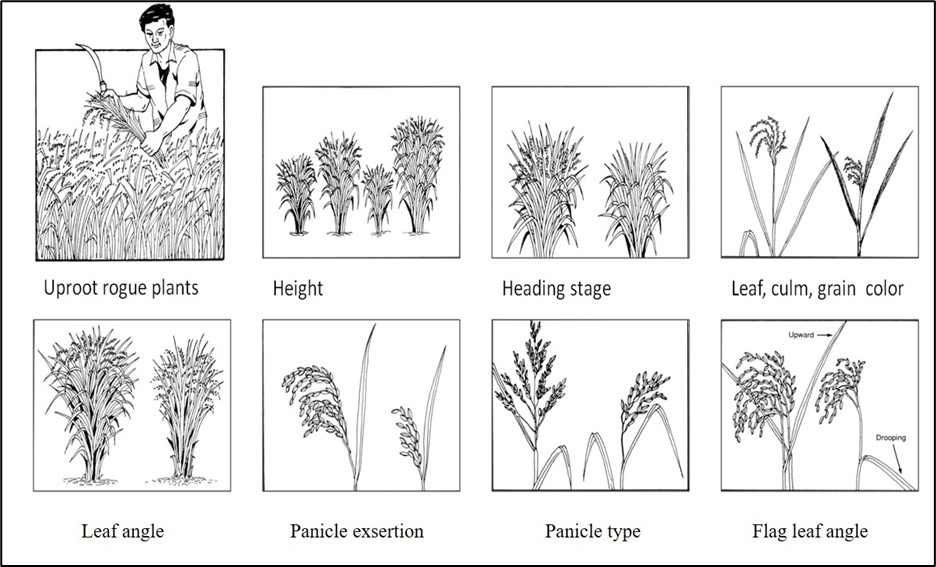
Rice crops should be checked regularly for insects and disease outbreaks. Control measures should only be adopted when pest number reaches an economic threshold level (ETL). Integrated pest management (IPM) is a sustainable approach of managing pests by combining cultural, mechanical, biological, and chemical tools in a way that minimizes economic, health and environmental risks. Some examples of integrated pest management are presented in figure below. The integrated crop management is a better approach to control pests and diseases in the seed production field.
Care should be taken to ensure that the genetic purity of the seed crop is maintained, to avoid mixtures when harvesting more than one variety. The higher the quality of the seed, the greater the care is required in harvesting and threshing. Breeder seed is often hand harvested and threshed with a mechanical self-cleaning thresher, while the foundation and certified seeds can be harvested using reaper.
Check crop moisture levels: The optimal stage to harvest rice seed crop is between 20-25% grain moisture or when 80-85% of the grains are straw-colored and the seeds in the lower part of the panicle are in the hard dough stage.
Seed is separated from the panicle by impact or stripping from the panicle. This can be done either manually or by machine. Machines are more efficient at threshing high seed-moisture content but also have the potential to cause damage if not set correctly. Machine threshers are best used for seed at 20-25% moisture while manual threshing is easier when moisture content of seed ranges from 14-18%. Engine operated open-drum thresher can be used for threshing operation of seed varieties to avoid mixing, reducing cost and early threshing. For the large-scale threshing of paddy seed, the axial flow thresher with drum rpm of 500-600 should be considered. Before use for one rice variety to another rice variety, the covered threshing drum and sieve should be cleaned by air blower or vacuum compressor pump.
It is important to dry the seed as soon as possible after harvest, and store safely.
Where possible, clean the seed before drying.
Traditional drying systems are still practiced in many areas because of their low cost and ease of management.
In mechanical drying systems, dryers are used to remove water from wet grains by forcing either ambient air or heated air through the grain bulk. Different types of dryer such as batch dryer , flat batch dryer, columner dryer and solar bubble dryer may be used for drying.
Moisture content (MC) is the weight of water contained in paddy or rice expressed in percent. MC is usually calculated on the wet basis, meaning that the total weight of the grain including the water (MCwb). For research purpose, the moisture content is often calculated on the basis of dry matter of the grain (MCdb).
Accurate moisture content testing is important in managing and marketing paddy and rice, because depending on the purpose, rice has different ideal moisture contents. Inaccurate moisture content measurements lead to:
Moisture content of seed can be measured by two methods:
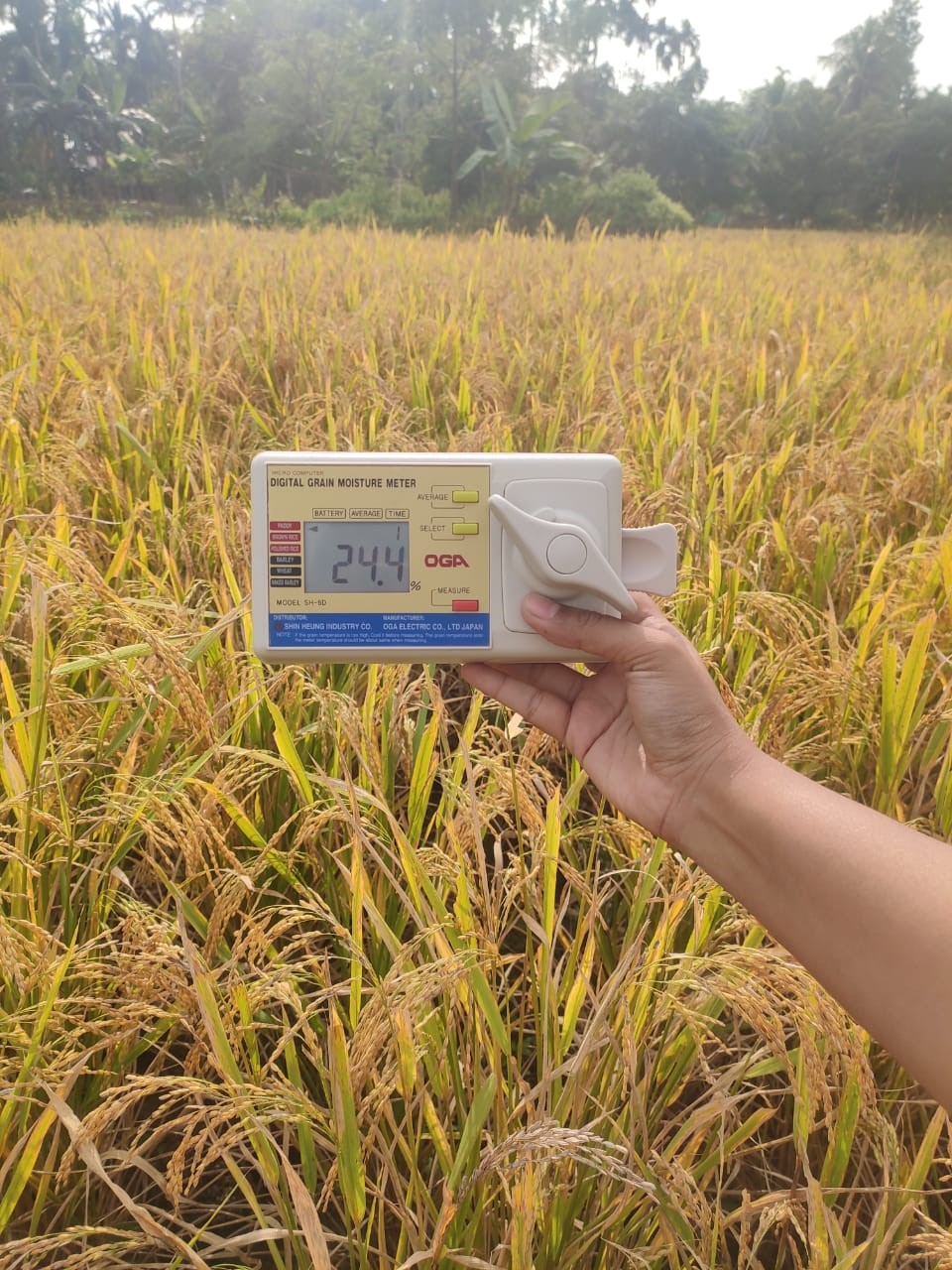
Disinfestation requires a systematic and thorough cleaning of all sources of infestation before storage.
Storage containers, structures and equipment can be treated with application of Neem Azal 1% @ 2-3 ml/L or NSKE 1500 ppm @ 3-5 ml/L.
All second-hand bags should be examined, and wherever necessary, treat them with either a fumigant, insecticide, or dip in boiling water. Solutions of Neem Azal 1% @ 2-3 ml/L or NSKE1500 ppm @ 3-5 ml/L can be used for dipping the bags. Aluminum phosphide @ 3 tablets per ton of rice grain or seed is used for storage.
The optimum moisture contents of rice seed stored up to 1 year is ˂12% but rice seed stored for more than one year should have optimum moisture content ˂ 9%. Seeds can be stored safely for extended periods, if it is:
Seed storage facilities take many forms depending on the quantity of seed to be stored, the purpose of storage, and the location of the store. Storage can be through bags, in bulk, or hermetic containers.
Hermetic storage: In this system, seed is stored in an airtight container so the moisture content of the stored seed or grain remains the same as when it was sealed. This system of storage can extend germination life of seeds, control grain pests, and improve head rice recovery. Examples includes (i) super bag, cocoon - commercially available. IRRI super bags are also available to the farmers at low cost, (ii) other locally available containers which are useful in rural settings, and can be easily converted into hermetic storage systems.
Stacking of seed bags: The following point should be considered for stacking of seed bags: (i) Seed bags preferably be stacked on a wooden pallet (platform), (ii) Avoid steel hook on bags as it causes spillage of seeds, (iii) Leave alley (moving) space between stacks and walls for inspection or sampling, (iv) Only 50-60% space should be utilized for seeds and (v) New harvest should not be stored with old stock.
Conditioning of paddy seed is very much essential. Seed processing plant should be used for processing of seed to maintain its quality. As per ASOCA, the processed seed through seed processing plant should be certified as foundation seed and certified seed. The following process is considering in the seed processing plant: (i) Seed should dry up to 12% moisture content before going for seed processing through the seed processing plant (ii) Cleaning (removal of dust, soil, straw and stones) through seed processing plant (iii) Grading (removal of non-seed and chaffy grain) through seed processing plant (iv) Gravity separator (removal of non-seed and broken grain) to get equal-sized quality seed through seed processing plant Malformed, discolored, germinated, broken or moldy seed in seed lots can severely impact seed quality, viability and vigor.
A seed cleaner uses a combination of components for winnowing, including a fan to remove lighter particles (e.g. empty grains) and sifting with sieves on an oscillating screen to remove particles that are smaller (e.g. weed seeds) and larger (e.g. straw).
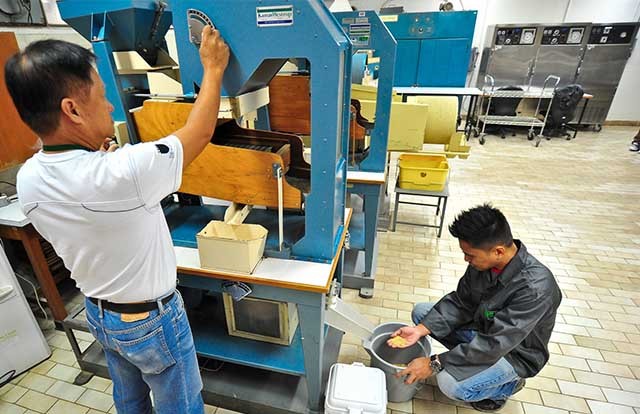
For commercial seed processing, seed should have uniform size and weight. A variety of commercial equipment can be used to achieve uniformity in seed size and shape. These include gravity tables, rotary screens, indented cylinders, and length graders.
Maintain seed purity by preventing mixture with other varieties, and contamination with other species.
Soon after completion of the seed processing or after seed treatment, as the case may be, the Certification Agency shall draw a representative composite sample as per procedure specified in Seed Testing Manual. The quantity of seed samples so drawn shall be sufficient to provide three samples of the size of submitted sample. The composite sample is divided into three equal parts: one is sent for analysis to a notified Seed Testing Laboratory, the second to the seed producer, and the third is retained as a guard sample.
The Seed Testing Laboratory analyzes the seed samples in accordance with the prescribed procedure and delivers the Seed Analysis Report to the Certification Agency as soon as may be, but not later than 30 days from the date of receipt of the samples unless the seed is subjected to such tests which require more than 30 days for completion of the test.
All certified seed lots shall conform to the following Minimum Standards for genetic purity unless otherwise prescribed:
| Class | Standards for minimum genetic purity (%) |
|---|---|
| Foundation | 98 |
| Certified | - |
| Varieties | 98 |
| Hybrids | 95 |
The Certification Agency shall conduct grow-out test to determine genetic purity of a seed lot whenever it is a pre-requisite for grant of the certificate, and also on the seed lots where a doubt has arisen about the genetic purity. The grow-out test can be complemented by certain related laboratory tests. The grow-out test shall be conducted as per the procedure specified.
When a seed lot does not meet the prescribed seed standards, the Certification Agency, on the request of seed producer, may permit recleaning, resampling and retesting. The recleaning, resampling and retesting shall be permitted only once.
A seed lot under certification shall not have apparent or visible evidence of damage by insects for both Foundation and Certified seed classes in excess of 1.0% for the seeds of maize and legumes, and 0.50% for the seeds other than maize and legumes, unless otherwise prescribed.
Seed standards in respect of seed moisture shall be met at the time of packing of seed.
If a seed field or a seed lot is not found meeting prescribed standards for the class for which it has been registered but conforms to the prescribed standards to the immediate lower class, the Certification Agency may accept such seed fields/seed lots for certification to the immediate lower class, provided the request has been made to this effect by the seed producer. However, downgrading of the seed class shall not be applicable in case of hybrids and their parents.
| Factor | Foundation | Certified |
|---|---|---|
| Pure seed (% minimum) | 98 | 98 |
| Inert matter (% maximum) | 2 | 2 |
| Huskless seeds (% maximum) | 2 | 2 |
| Other crop seeds (Number of seed/kg maximum) | 10 | 20 |
| Other distinguishable varieties (Number of seed/kg maximum) | 10 | 20 |
| Weed seeds (Number of seed/kg maximum) | 10 | 20 |
| Objectionable weed seeds (Number of seed/kg maximum) | 2 | 5 |
| Seeds infected by paddy bunt (Neovossia horrida (Tak.) Padwick & Azmatulla Khan. (% maximum)) | 0.10 | 0.50 |
| Germination (% minimum) | 80 | 80 |
| PMoisture content (%) | 13 | 13 |
| Moisture content for vapor proof container (maximum) | 8 | 8 |
Jorhat, PIN - 785013 Assam